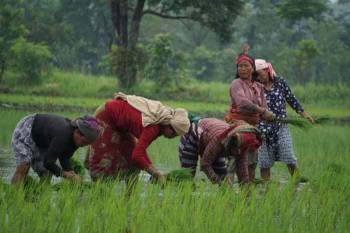KATHMANDU / Nepal, 17 May 2025: Nepal’s agriculture, which supports 62% of the population and contributes nearly a quarter of the country’s GDP, faces significant challenges from climate change, youth migration, and limited energy access.
A recent study by the International Renewable Energy Agency (IRENA), in partnership with Nepal’s government and key agencies like the Alternative Energy Promotion Centre (AEPC) and Ministry of Agriculture and Livestock Development (MoALD), reveals how decentralized renewable energy (DRE) could revolutionize farming by boosting productivity, cutting emissions, and increasing resilience.
The study examined four vital agricultural value chains — maize, apples, fish, and millet — chosen for their importance to food security and potential for mechanization. Findings highlight the promise of DRE-powered technologies such as solar water pumps, dryers, cold storage, and mini-grids to reduce the sector’s dependence on diesel and provide reliable, clean energy.
In Nepal’s Dang district, maize is the second most cultivated crop. Here, 44% of maize-processing equipment—including shellers, dryers, and water pumps—could run on DRE, potentially offsetting 120 million kilowatt-hours of fossil-fuel energy annually. Achieving this would require an investment of about USD 87 million and could reduce CO₂ emissions by over 206,000 tonnes.
Similarly, apple farming in the mountainous Jumla district currently relies on diesel generators due to unreliable electricity. Transitioning to solar-powered graders and juice makers could cut fossil fuel use by 41%, with an estimated investment of USD 1.1 million.
Fish farming, concentrated in the Terai region, depends on continuous power for water circulation and aeration. Frequent outages force farms to use expensive diesel generators. Solar-powered pumps and dryers could reduce fossil fuel consumption by 42%, requiring USD 1.2 million in investment.
Millet farming in hilly areas shows moderate potential for DRE adoption through solar-powered threshers and mills, with a required investment of USD 24 million.
The report stresses the need for close collaboration between Nepal’s Ministries of Agriculture and Energy to integrate planning and budget allocation. It also calls for awareness campaigns and targeted training for farmers—especially women, whose involvement in system design and maintenance can improve livelihoods and promote gender equality.
For sustainable impact, the study recommends stronger business models and financing mechanisms focused on enterprises serving multiple farmers and favoring community-level installations over individual setups.
By integrating decentralized renewable energy, Nepal can significantly increase agricultural productivity, lower greenhouse gas emissions, and foster inclusive rural development. With strategic investments and supportive policies, a cleaner, more resilient agricultural future is within reach over the next five years.




















